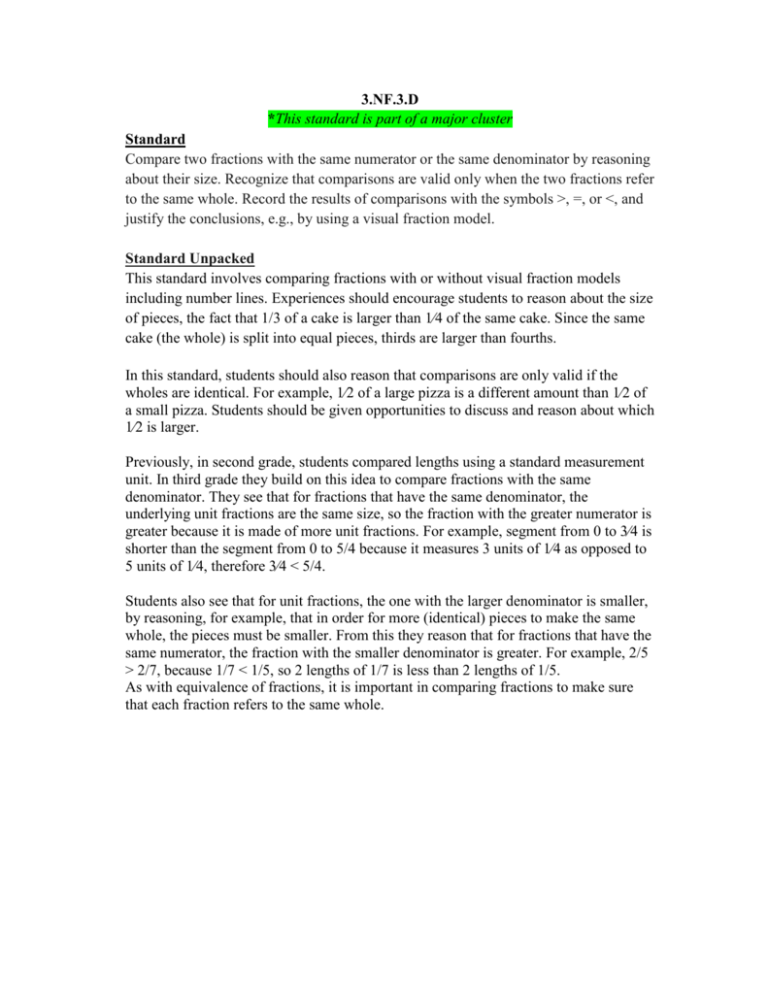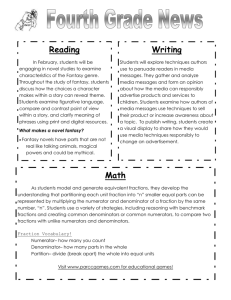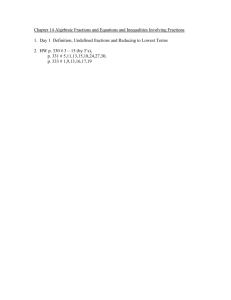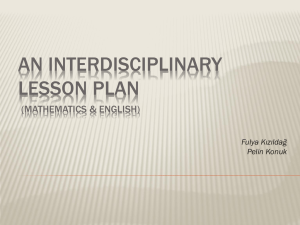3.NF_.3.D1
advertisement

3.NF.3.D *This standard is part of a major cluster Standard Compare two fractions with the same numerator or the same denominator by reasoning about their size. Recognize that comparisons are valid only when the two fractions refer to the same whole. Record the results of comparisons with the symbols >, =, or <, and justify the conclusions, e.g., by using a visual fraction model. Standard Unpacked This standard involves comparing fractions with or without visual fraction models including number lines. Experiences should encourage students to reason about the size of pieces, the fact that 1/3 of a cake is larger than 1⁄4 of the same cake. Since the same cake (the whole) is split into equal pieces, thirds are larger than fourths. In this standard, students should also reason that comparisons are only valid if the wholes are identical. For example, 1⁄2 of a large pizza is a different amount than 1⁄2 of a small pizza. Students should be given opportunities to discuss and reason about which 1⁄2 is larger. Previously, in second grade, students compared lengths using a standard measurement unit. In third grade they build on this idea to compare fractions with the same denominator. They see that for fractions that have the same denominator, the underlying unit fractions are the same size, so the fraction with the greater numerator is greater because it is made of more unit fractions. For example, segment from 0 to 3⁄4 is shorter than the segment from 0 to 5/4 because it measures 3 units of 1⁄4 as opposed to 5 units of 1⁄4, therefore 3⁄4 < 5/4. Students also see that for unit fractions, the one with the larger denominator is smaller, by reasoning, for example, that in order for more (identical) pieces to make the same whole, the pieces must be smaller. From this they reason that for fractions that have the same numerator, the fraction with the smaller denominator is greater. For example, 2/5 > 2/7, because 1/7 < 1/5, so 2 lengths of 1/7 is less than 2 lengths of 1/5. As with equivalence of fractions, it is important in comparing fractions to make sure that each fraction refers to the same whole. There is substantial evidence to suggest that the effective use of models in fraction tasks is important (Cramer & Henry, 2002; Siebert & Gaskin, 2006). Unfortunately, textbooks rarely use manipulatives, and when they do, they tend to only be area models (Hodges, Cadey, & Collins, 2008). This means that students often do not get to explore fractions with a variety of models and/or do not have sufficient time to connect to the models to the related concepts. In fact, what appears to be critical in the learning is that the use of physical tools leads to the use of mental models, and this builds students’ understanding of fractions (Cramer & Whitney 2010; Petit, Laird & Marsden, 2010). Examples: Example: Using set models to compare. (it is important that students are able to compare fractions as a set, and are not limited to thinking of fractions in terms of area models only). Adilen has a set of buttons. She has 8 buttons total. 3/8 of them are blue and 5/8 of them are pink. She is trying to describe to her brother which set she has more of. Here is her model: Example: Asking students to model how much coffee each person would get if they were only to receive 1/3 of each size, and then compare the results. Guiding a discussion in regard to what they notice about 1/3 of each size could lead into the understanding that while all three cups can be divided into three equal parts, the actual size of each third is different depending on the size of the whole. Example: In this type of example, a student might reason that since each fraction is divided into equal size pieces (the denominator), they can then reason about the amount of shaded parts (the numerator). Questions/ Activities to check for understanding and increase rigor: • Choose two fractions with different denominators, but the same numerator (for example ⅜ and ⅞. Explain which fraction is smaller or larger and why that is. • Have students use linking cubes to show why ⅔ = 4/6. • Without drawing a picture or using a number line, Danielle says that ⅜ is not equal to 3/6 ? Is she right or wrong? Explain why or why not. • Find a fraction that is greater than three fourths? Greater than ⅓, but less than ½? Greater than one? Justify your answers. • What if a friend offered you ¾ of a cookie or ⅝ of a cookie. Which fraction of the cookie would be greater? Model your reasoning.








